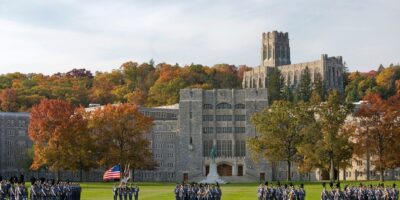Smash the COVID Orthodoxy

For better or for worse, the American Institute for Economic Research was built for a time just like this. The date is 1933, the world is having a debate over whether to adopt Communism or Fascism. The intellectual class scoffs at the ideas of economic and social freedom, believing that society had advanced towards a new era where everything and anything could be planned. They assert that with the scientific and awesome hand of government, we could conquer nature, eliminate strife, and construct a new world.
President Roosevelt unleashed an unprecedented assault on the principles of sound economics and limited government. Against vast criticism and tremendous controversy, a young US Army Colonel and MIT Professor by the name of Edward C. Harwood spoke out against the regime and founded a small research institution: AIER.
He challenged John Maynard Keynes, an economist who enjoyed near deity status as his ideas served as the foundation for the new order. Harwood’s defense of markets, of sound fiscal spending, of responsible monetary policy, would soon be joined by an ever-growing number of organizations and individuals. All because one man decided to defy the orthodoxy, speak truth to power, and ask the necessary questions that nobody else would. His legacy along with the ideas he wished to preserve have survived and continue to grow in support.
Fast forward to the current day and once again AIER finds itself as one of the few, if any, organizations that are willing to ask the right questions and say what others are afraid to say. We face a new orthodoxy where silence and compliance has and will continue to produce dire consequences. The conversation surrounding COVID-19 has been dangerously one-sided to the point where critical considerations and questions have been largely relegated to the fringes. A failure to diversify and open up the national discourse, much like Harwood did, will have long-lasting consequences that extend far beyond the current crisis.
Perhaps the ongoing strategy regarding social distancing and lockdowns is the best we can do, but we will never know unless there is ample room for diversity of thought.
The gatekeepers of news and information should be asked why there has been a sudden shift from COVID-19 deaths to simply new “cases.” Perhaps it has something to do with the fact that the death rate is at less than a third of where it was during the peak.
When we examine the data regarding those who are most likely to die from COVID-19 we find that the median age of death is situated around the 75 years and above bracket, which also sits around the average life expectancy in the US. We also find that 43% of all deaths in the country occur at nursing homes, which in their entirety hold less than 1% of total population.
To put this into context, Gregory van Kipnis writes
“Deaths expressed as a percent of those living in medical care institutions, is 0.682%, more than 50 times the death rate of the rest of the population at 0.012%. The death rate for the overall population is 0.022%.”
Perhaps the conversation should be around protecting nursing home residents and not shutting down the economy. Perhaps we shouldn’t be sold a false dichotomy that we need to choose between getting a haircut and saving someone’s life. When it comes to flattening the curve, in regards to deaths we have not only flattened it, we have driven it into the ground.
However, instead of celebrating, the COVID orthodoxy – the World Health Organization, the US government, the intellectual class, their corporate allies, and the mainstream media – have shifted the goal posts. They have pivoted to concerns about new cases and threaten to renew the lockdowns.
If the COVID orthodoxy wants to pivot to talk about rising cases and hospitalizations there are still very important questions to be raised. First, there must be a methodological clarification. Such as the fact that because testing has become more available that will inevitably lead to more reported cases. Furthermore, when we hear about a “record number of infections” we must also clarify that any increase in COVID-19 cases leads to a new record high. Also we must ask where and why are these new cases appearing? According to the New York Times
“Cases of the coronavirus in prisons and jails across the United States have soared in recent weeks, even as the overall daily infection rate in the nation has remained relatively flat.
The number of prison inmates known to be infected has doubled during the past month to more than 68,000. Prison deaths tied to the coronavirus have also risen, by 73 percent since mid-May.”
Again this is a critical point of information that draws into question the claim that normal people going out and living their lives is leading to a catastrophic spread of COVID-19. However, there is little talk about the abhorrent state of our prison system in addressing rising infections. We are still sold a narrative that going out for lunch is spreading the virus, not terrible management of nursing homes, prisons, and meatpacking plants.
When it comes to the overall number of infections as of July 1, 2020, there are approximately 2.7 million confirmed cases in the United States, but also 798,442 confirmed recoveries. The total US population is roughly 330 million, which means that less than 1% of the population has been infected. Remember that a large portion of these cases reside in nursing homes and prisons. When we hear reports of hospitals being flooded, part of the equation includes young people who now fit the looser vetting criteria because testing kits have become more common. Factor in that many of the cases outside these institutions are concentrated in urban populations and you are left with a very different picture than the narrative that we are currently being given.
Worldwide roughly half of the 10.6 million individuals confirmed to have contracted COVID-19 have been confirmed to have recovered. However, the World Health Organization and other groups neglect to display the number of recoveries, only cases and deaths. This only serves to heighten hysteria and concern, driving a narrative that leaves little room for optimism, which we desperately need.
It is also reported that around 80% of cases only experience mild symptoms which are certainly not desirable but will subside in about 2 weeks. Some people experience very little symptoms at all. The WHO also cannot confirm with any certainty the rate of asymptomatic spreading as there have been no officially documented cases. At the end of the day contracting the virus in any capacity results in antibodies that can provide immunity against further infection. Contracting the virus isn’t pleasant, but it seems we may be better served if we did not overemphasize the danger of COVID-19 and instead consider it with a broader perspective.
Perhaps the greatest authority that needs to be challenged at the moment are the lockdown architects, the epidemiologists, and their lackeys that perpetuate fear while also crushing dissent. One of the greatest culprits is British Professor Neil Ferguson who was the architect behind the English lockdown strategy. His models predicted that essentially the streets would run with blood unless his ‘Stay Home’ plan was implemented. Ultimately his predictions were wildly incorrect but the British people had to pay for his miscalculations.
Gregory van Kipnis writes about the problematic methods used by the epidemiologists that we have given far too much power by stating
“The Fatal Conceit of bureaucrats in the service of politicians is that they imagine they know more than they actually need to know to design appropriate policy. They employ many scientists who struggle to maintain objectivity, but it is easy for those who control their budgets to pick and choose whose work they will support. Small errors of assumptions can produce large errors of policy.”
Yet the orthodoxy and the arbiters of public opinion have only advocated for more lockdowns, more disruption of social life, and have demonized those who have said otherwise.
Facebook has been a contributor to suppressing the conversation as it has taken to policing content around COVID-19, oftentimes in favor of the status quo. A viral piece published by AIER noting how Woodstock occurred during the Hong Kong Flu Pandemic was amongst those victims. Facebook’s fact-checkers deemed it to be misleading but USA Today found it to be true. At the end of the day, the piece was written in a good faith attempt to provide some important context and perspective to the conversation, in favor of moderation. By suppressing dissent we only lead ourselves blindly to disaster.
If Jeffrey Tucker’s insight on Woodstock is not persuasive enough perhaps the writings of the legendary doctor, Donald Henderson, will. He along with others wrote
“Experience has shown that communities faced with epidemics or other adverse events respond best and with the least anxiety when the normal social functioning of the community is least disrupted.”
Henderson passed away in 2016 and one of his greatest contributions was leading the eradication of smallpox.
All these considerations and questions lead us to the ultimate question that should be brought to the COVID orthodoxy: the government officials, the epidemiologists, the corporate collaborators, and the lockdown advocates.
After all the experiments are concluded, the last model is drawn, and the utter curtailing of our liberties and autonomy is complete. The question is this: Where should we be at the end of all this?
I am a 22-year old college graduate. I can easily retreat to drinking with my friends at my parent’s house and then enroll in a nice graduate school in a few months. Perhaps my talents will bring me a lucrative position enforcing the “new normal.”
I can’t say the same of those less fortunate, whose livelihoods have been destroyed. Just last week I was in New Hampshire and I attempted to call in an order at a restaurant in a small rural town in Coos County. After multiple attempts, I realized that this once-proud business on the other side of the line no longer exists. I don’t know the owners, I will never meet them, but I can assume that like my family they immigrated to America in search of opportunity, to build a better future. Now their dreams and hard work have been crushed by a sweeping government mandate. There were only 7 total confirmed cases of COVID-19 and 0 deaths recorded in Coos County.
All we are told is that we must close the economy, practice social distancing, and wear masks to flatten the curve. Has anyone asked what else this will do? Have we considered the absolute devastation that has been levied on communities, the crushing of dreams, the draining of the human spirit?
The American Psychological Association writes
“Families cooped up together because of stay-at-home orders are chafing under the stress, which may increase the risk of intimate partner violence and child abuse. Disrupted routines and the potential for contracting a life-threatening disease may be exacerbating preexisting problems such as mental illness or substance use. At the same time, physical distancing is endangering mental health even as it protects physical health.”
This is a result of lockdowns that we will seldom hear about. The consequences cannot be accounted for in a neat model. Concerns about the long-lasting economic effects of the lockdown are oftentimes eschewed as a tradeoff between haircuts and lives. That dichotomy is false. The economic devastation is real.
According to CNBC, the Atlanta Fed projects that second-quarter GDP will fall 52.8%. The Federal Reserve stated that it intends to keep interest rates near zero until 2022. There are countless small businesses that have shut their doors and will never open again. The unemployment rate is skyrocketing and some jobs will never come back.
The Trump administration just suspended immigration to the United States, purportedly in response to COVID-19. International workers and students are being forced to leave their lives in the US.
Protests against police brutality and racism as a result of the murder of George Floyd rocked the country to its core with far greater fervor than other racially charged killings. The reason can likely be attributed to the lockdowns.
The United States of America, the greatest economic superpower in the history of the world and an icon of freedom brought itself to its knees because of awful policymaking.
When Jeffrey Tucker addressed a crowd of hundreds at this year’s Porcfest, an annual gathering of freedom lovers, he noted
“You could see the tragedy and hope in people’s eyes”.
The emotions were palpable that night. There was something different about this once rowdy and carefree group of freedom lovers. He could tell by all the drinking and substance usage that we have all been through hell. He noted that we should congratulate ourselves for simply being alive.
US News writes that
“The Lancet Psychiatry, an international group of suicide experts advocated “urgent consideration” to prevent a rise in suicide rates, especially as COVID-19 – and its devastating economic impact – drag on for months.”
These are numbers and cases we seldom hear about as we are told to keep our eyes glued to the WHO and our state health agencies. Pay attention to new cases, not rising suicides, substance abuse, unemployment, domestic violence, and a whole load of other issues brought by closing the economy. Where are our experts and courageous politicians when it comes to addressing these concerns? This is why the orthodoxy of acceptable discussion must be challenged and new questions need to be asked. If not to propose new policies, to amend and correct the existing ones. We gain nothing if we are simply made to listen and nod.
Diversifying the national conversation is critical because the current monologue is leading us to a place we may never fully recover from. We may never reclaim our freedoms, our livelihoods, or our loved ones. A working paper from the University of Chicago provides a chilling observation that government policy has only accounted for a small percentage of the economic downturn. It is consumer sentiment, the voluntary actions of individuals in fear, that has truly brought about economic calamity. The need to challenge the orthodoxy and its regime of fear goes beyond policy. Doing so must bring hope and optimism back to society.
Edward C. Hardwood founded AIER at a time where the national and global conversation was hopelessly swayed against the principles he stood for. AIER was the brave voice espousing freedom and responsibility in a world where Fascism and Communism were on the rise. His voice was eventually joined by an ever growing chorus that advocated for the principles of a free society and sound policymaking. Today is no different.
In a time of industrial levels of draconian lockdown measures, of fear-mongering and politicization, a failure to speak out against the orthodoxy will only lead to more pain and suffering. Perhaps the status quo is the best way forward, but we will never know unless we have more voices in the conversation. When this is all over, history will remember those who were brave enough to speak out, insightful enough to weigh all the options, wise enough to consider the future, and most importantly those who stood for principle.










